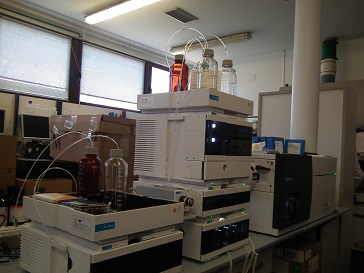 |
|
||
IEC group > Technological & Scientific Equipment
Electrochemical Engineering and Corrosion laboratory
ULTRA HIGH PERFORMANCE LIQUID CHROMATOGRAPHY-UHPLC WITH DIODE ARRAY DETECTOR (DAD) COUPLED TO A HIGH RESOLUTION MASS SPECTROMETER AND EXACT MASS WITH TIME OF FLIGHT ANALYZER (Q-TOF)

An Ultra High Resolution Liquid Chromatograph (Ultra High-Performance Liquid Chromatography with Photodiode-Array Detection, UHPLC-DAD) - Mass Spectrometer is a flexible equipment that allows working as a UHPLC with Diode Array detection or UHPLC coupled to a Mass Spectrometer.
High performance liquid chromatography (UHPLC) is the most widely used technique foe the separation of substances.
Mass Spectrometry is a microanalytical technique used to identify unknown compounds, to quantify known compounds, and to elucidate the structure and chemical properties of molecules.
The association of the two techniques, UHPLC (Ultra High-Performance Liquid Chromatography) and MS (Mass Spectrometry) results in a combined UHPLC (LC) -MS technique that allows the separation and identification of complex mixtures.
LC-MS is liquid chromatography (usually ultra high performance liquid chromatography, UHPLC) combined with mass spectrometry. Here the sample is injected in liquid form into the LC and the different chemical components are separated (they travel at different speeds through the column due to their different affinities for the stationary phase, the coating inside the column and the mobile phase, passing the solvent through the column). The output of the LC column is then directed to a mass spectrometer where it is ionized (usually using electrospray ionization (ESI)) and a mass spectrum is generated. This allows a better chemical identification or specificity.
The UHPLC-MS is an indispensable tool in any analysis laboratory that has been used both for the identification of biological, clinical or environmental species (purely qualitative aspect) and for the determination of their concentration (quantitative analysis):
- Analysis of environmental pollutants through LC-MS.
- Structural analysis of peptides and proteins. Peptide mapping. Sequencing.
- Applications in the Environmental field, Bioanalysis and Clinical/Pharmaceutical analysis.
- Determination of the different types of polyphenols in the diet. They are powerful antioxidants and their recovery presents great interest for the food, pharmaceutical and cosmetic industries.
This equipment allows the analysis, monitoring and characterization of the degradation of organic pollutants. It is important to know the species in which the organic pollutants are degraded, since their incomplet mineralization could result in degradation products which may be more polluting than the starting organic product.
Thanks to the 2018 call for grants for infrastructure and equipment for R & D & I for the period 2018-2020 (ERDF Operational Programme 2014-2020 of Comunitat Valenciana), the UHPLC-MS has been acquired on 2019 (co-funded by the European Regional Development Fund of the European Union and Generalitat Valenciana),reference IDIFEDER2018/044.
The acquired equipment has the potential to qualitatively characterize and quantify the known and unknown substances present in a solution. It also allows knowing the mechanisms and reaction intermediates when the problem substance is degraded by different ways. Nowadays, in the research work on degradation of emerging pollutants, not only the degradation ratio is asked, but also its degradation mechanism as well as the degradation products. This equipment allows answering these questions.

 
|
